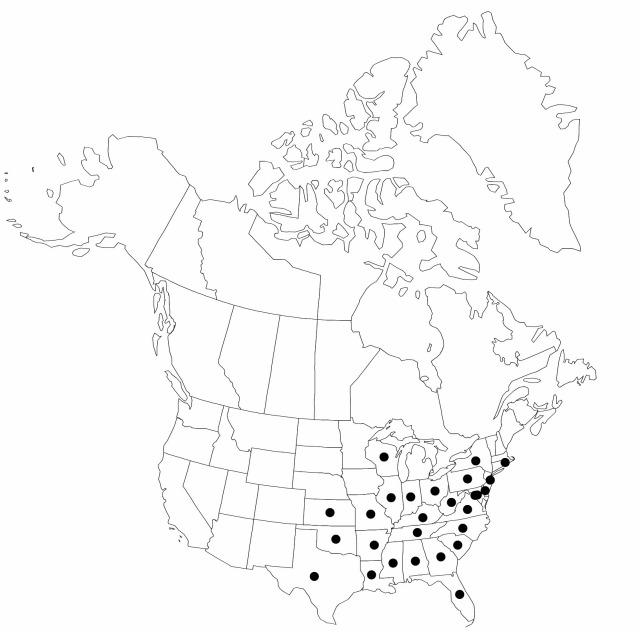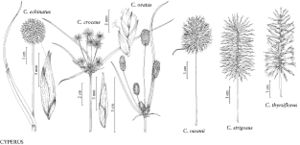Difference between revisions of "Cyperus echinatus"
Class-book Bot. ed. s.n.(b), 734. 1861.
FNA>Volume Importer |
imported>Volume Importer |
||
| (6 intermediate revisions by 2 users not shown) | |||
| Line 8: | Line 8: | ||
}} | }} | ||
|common_names=Teasel sedge | |common_names=Teasel sedge | ||
| − | |basionyms={{Treatment/ID/ | + | |special_status={{Treatment/ID/Special_status |
| + | |code=F | ||
| + | |label=Illustrated | ||
| + | }} | ||
| + | |basionyms={{Treatment/ID/Basionym | ||
|name=Scirpus echinatus | |name=Scirpus echinatus | ||
|authority=Linnaeus | |authority=Linnaeus | ||
| + | |rank=species | ||
| + | |publication_title=Sp. Pl. | ||
| + | |publication_place=1: 50. 1753 | ||
}} | }} | ||
|synonyms={{Treatment/ID/Synonym | |synonyms={{Treatment/ID/Synonym | ||
|name=Cyperus ovularis | |name=Cyperus ovularis | ||
|authority=(Michaux) Torrey | |authority=(Michaux) Torrey | ||
| − | }}{{Treatment/ID/Synonym | + | |rank=species |
| + | }} {{Treatment/ID/Synonym | ||
|name=Cyperus ovularis var. americanus | |name=Cyperus ovularis var. americanus | ||
|authority=Boeckeler | |authority=Boeckeler | ||
| − | }}{{Treatment/ID/Synonym | + | |rank=variety |
| + | }} {{Treatment/ID/Synonym | ||
|name=Cyperus ovularis var. sphaericus | |name=Cyperus ovularis var. sphaericus | ||
|authority=Boeckeler | |authority=Boeckeler | ||
| − | }}{{Treatment/ID/Synonym | + | |rank=variety |
| + | }} {{Treatment/ID/Synonym | ||
|name=Cyperus ovularis var. wolfii | |name=Cyperus ovularis var. wolfii | ||
|authority=(Alph. Wood) Kükenthal | |authority=(Alph. Wood) Kükenthal | ||
| − | }}{{Treatment/ID/Synonym | + | |rank=variety |
| + | }} {{Treatment/ID/Synonym | ||
|name=Cyperus wolfii | |name=Cyperus wolfii | ||
| − | |authority= | + | |authority= |
| − | }}{{Treatment/ID/Synonym | + | |rank=species |
| + | }} {{Treatment/ID/Synonym | ||
|name=Kyllinga ovularis | |name=Kyllinga ovularis | ||
| − | |authority= | + | |authority= |
| − | }}{{Treatment/ID/Synonym | + | |rank=species |
| + | }} {{Treatment/ID/Synonym | ||
|name=Mariscus ovularis | |name=Mariscus ovularis | ||
| − | |authority= | + | |authority= |
| + | |rank=species | ||
}} | }} | ||
|hierarchy=Cyperaceae;Cyperus;Cyperus subg. Cyperus;Cyperus echinatus | |hierarchy=Cyperaceae;Cyperus;Cyperus subg. Cyperus;Cyperus echinatus | ||
| Line 49: | Line 63: | ||
|distribution=Ala.;Ark.;Del.;D.C.;Fla.;Ga.;Ill.;Ind.;Kans.;Ky.;La.;Md.;Miss.;Mo.;N.J.;N.Y.;N.C.;Ohio;Okla.;Pa.;R.I.;S.C.;Tenn.;Tex.;Va.;W.Va.;Wis.;West Indies. | |distribution=Ala.;Ark.;Del.;D.C.;Fla.;Ga.;Ill.;Ind.;Kans.;Ky.;La.;Md.;Miss.;Mo.;N.J.;N.Y.;N.C.;Ohio;Okla.;Pa.;R.I.;S.C.;Tenn.;Tex.;Va.;W.Va.;Wis.;West Indies. | ||
|discussion=<p>The records for Rhode Island and Wisconsin are according to M. L. Horvat (1941); we have not seen specimens from those states.</p><!-- | |discussion=<p>The records for Rhode Island and Wisconsin are according to M. L. Horvat (1941); we have not seen specimens from those states.</p><!-- | ||
| − | --><p>Cyperus echinatus is usually recognized by its tight, nearly spheric spikes; it may occasionally be hard to distinguish from C. croceus and C. retrorsus. Compared to C. retrorsus, C. echinatus has larger spikelets and longer floral scales, anthers, and achenes. In contrast to C. echinatus, C. croceus has looser spikes, shorter, broader, greenish or yellowish floral scales, shorter, more ovoid achenes, and shorter anthers. Furthermore, C. echinatus is predominantly an inland species of roadsides, pastures, and other disturbed ground; C. retrorsus is primarily a coastal species and occurs in drier, sandier sites.</p> | + | --><p><i>Cyperus echinatus</i> is usually recognized by its tight, nearly spheric spikes; it may occasionally be hard to distinguish from <i>C. croceus</i> and <i>C. retrorsus</i>. Compared to <i>C. retrorsus</i>, <i>C. echinatus</i> has larger spikelets and longer floral scales, anthers, and achenes. In contrast to <i>C. echinatus</i>, <i>C. croceus</i> has looser spikes, shorter, broader, greenish or yellowish floral scales, shorter, more ovoid achenes, and shorter anthers. Furthermore, <i>C. echinatus</i> is predominantly an inland species of roadsides, pastures, and other disturbed ground; <i>C. retrorsus</i> is primarily a coastal species and occurs in drier, sandier sites.</p> |
|tables= | |tables= | ||
|references= | |references= | ||
| Line 58: | Line 72: | ||
-->{{#Taxon: | -->{{#Taxon: | ||
name=Cyperus echinatus | name=Cyperus echinatus | ||
| − | |||
|authority=(Linnaeus) Alph. Wood | |authority=(Linnaeus) Alph. Wood | ||
|rank=species | |rank=species | ||
| Line 72: | Line 85: | ||
|publication title=Class-book Bot. ed. s.n.(b), | |publication title=Class-book Bot. ed. s.n.(b), | ||
|publication year=1861 | |publication year=1861 | ||
| − | |special status= | + | |special status=Illustrated |
| − | |source xml=https:// | + | |source xml=https://bitbucket.org/aafc-mbb/fna-data-curation/src/2e0870ddd59836b60bcf96646a41e87ea5a5943a/coarse_grained_fna_xml/V23/V23_312.xml |
|genus=Cyperus | |genus=Cyperus | ||
|subgenus=Cyperus subg. Cyperus | |subgenus=Cyperus subg. Cyperus | ||
Latest revision as of 20:39, 5 November 2020
Herbs, perennial, single-stemmed to loosely cespitose. Culms basally cormlike, trigonous, (15–)30–100 cm × 0.5–3.5 mm, glabrous. Leaves flat to V-shaped, 10–65 cm × 3–9 mm, adaxial surface, margins minutely scabridulous. Inflorescences: spikes densely globose to globose-ovoid, 8–17 mm wide; rays 3–12, 2–12 cm, scaberous adaxially especially distally; rachis 4–8 mm; bracts (3–)4–7, ascending at 30(–45)°, flat, 5–35 cm × 2–9 mm; rachilla persistent, wings 0.5–0.7 mm wide. Spikelets 50–100, oblong-lanceoloid, ± terete-quadrangular, (3.5–)4–7 × 1–1.4 mm; distal spikelet spreading or ascending; floral scales persistent, 3–5, appressed, stramineous to brownish, 4-ribbed laterally, oblong-elliptic, 3.5–4.5 × 1–1.8 mm, membranous, apex entire or emarginate with mucro to 0.3 mm. Flowers: anthers 0.4–0.8 mm; styles 0.5–0.6 mm; stigmas 1 mm. Achenes brown, ± stipitate, oblong, (1.5–)1.8–2.3 × 0.5–0.6(–0.7) mm (1/2 length of floral scales), apex obtuse, surfaces puncticulate.
Phenology: Fruiting summer–early fall.
Habitat: Disturbed, sunny sites, in mesic places, well-drained soils
Elevation: 0–500 m
Distribution

Ala., Ark., Del., D.C., Fla., Ga., Ill., Ind., Kans., Ky., La., Md., Miss., Mo., N.J., N.Y., N.C., Ohio, Okla., Pa., R.I., S.C., Tenn., Tex., Va., W.Va., Wis., West Indies.
Discussion
The records for Rhode Island and Wisconsin are according to M. L. Horvat (1941); we have not seen specimens from those states.
Cyperus echinatus is usually recognized by its tight, nearly spheric spikes; it may occasionally be hard to distinguish from C. croceus and C. retrorsus. Compared to C. retrorsus, C. echinatus has larger spikelets and longer floral scales, anthers, and achenes. In contrast to C. echinatus, C. croceus has looser spikes, shorter, broader, greenish or yellowish floral scales, shorter, more ovoid achenes, and shorter anthers. Furthermore, C. echinatus is predominantly an inland species of roadsides, pastures, and other disturbed ground; C. retrorsus is primarily a coastal species and occurs in drier, sandier sites.
Selected References
None.
